GISMO run #6 (April 2012, 1st pool run)
Staffing
- GSFC: J. Staguhn, A. Kovacs, S. Maher, E. Sharp (1st week), D. Fixsen (first 4 days), D.Benford (last 5 days)
- IRAM: S. Leclercq (1st week), A. Sievers (1st week AoD), D. John (1st week), J. Abreu (2nd week AoD), S. Navarro (2nd week), C. Kramer (17-19 April), IRAM Granada staff
- Other observers: A. Karim (1st week), A.Edge (2nd week)
Schedule: 05.04. - 21.04.2012
IRAM 30m schedule page: http://www.iram.fr/IRAMFR/PV/sche/12/s15v1.html
GISMO log: https://mrt-lx1.iram.es/Devices/GISMO/ (internal)
Summarized schedule of the run:
Dates |
Main event |
Thursday 05/04 - Monday 09/04 |
Arrival of ES, SM and DF at the telescope with missing hardware, mount GISMO, cool down |
Tuesday 10/04 - Tuesday 17/04 |
Arrival of JS, AK, SL, and AK at the telescope, alignment, calibration/characterization work (see test plan), pooled projects observations, departure DF, ES |
Tuesday 17/04 - Tuesday 24/04 |
Departure SL AK, arrival DB AE, pooled projects observations |
GISMO final version
Same 8x16 pixels as 2nd to 5th test runs, working at 2mm (the –3dB window is 140-162 GHz), with an individual pixel size = 0.9 Fλ.
Same special features from previous runs: 2 motorized neutral density filters, controllable shutter, automated observing procedures usable via a dedicated GUI (see observer's manual), CRUSH reduction package.
- New updates: cold baffle, final position in the receiver cabin with corresponding warm optics (M5, M6), new cold pupil.
Daily reports
Thursday 05/04 - Monday 09/04
ES, DF and IRAM staff mounted and cooled down GISMO at its final position (see pictures below). Everything looks fine, based temperature reached, nice response of the detectors, first light on Saturn shows a nice shape indicating the optics is fine.
Tuesday 10/04
JS, AK, AK, SL, AS at the telescope. Alignment with laser (SN anf DJ). Everything looks fine, but weather is bad.
Here's some pictures of GISMO installed in the 30m receiver cabin:
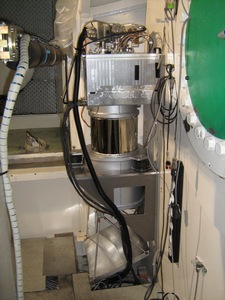
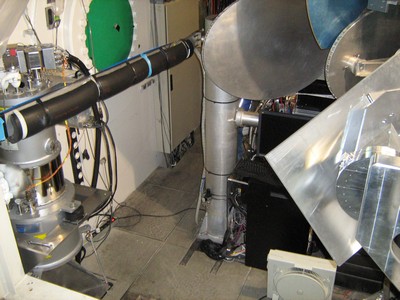
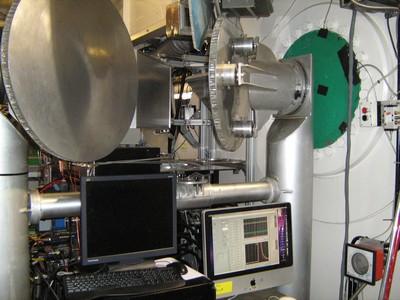
Mid afternoon: abnormal temperature rise on the detector package. Maybe a little touch somewhere, vibrations transmission ... investigation underway. Weather 100% humid anyway.
Wednesday 11/04
The cryogenic problem we experienced yesterday afternoon occurred after a helium transfer, but it's only several 10s of minutes latter that we saw the detector package start a slow and constant rise of temperature. The 2 main hypothesis were : a touch (something moved or broke) or a leak which didn't have an immediate effect because the charcoal in the cryostat was absorbing the incoming helium until it reached a saturation point. After several tests (eg moving filters) and brainstorming we pumped on the vacuum of the cryostat and noticed there was indeed gas in it, latter on we recycled the sorbtion fridges (3He and 4He) which had the effect to warm up all the detector package environment above 4K, while pumping on the vacuum. Then everything went back to normal and to base temperature. So we think the problem was maybe an o-ring that froze during the He transfer, and once it reached 4K during the recycling it "defroze" and went back into place. Everything went very fine during the night, first data processing shows we are surely below 10 mJy*s^0.5 ! Check the GISMO log link above to see observed sources list and pre-processed maps. First we looked at Mars for pointing / focus / flux calibration / first NEFD estimations / beam maps, then check responses on fainter sources such as quasars, and since everything was nice and weather good, had a first glimpse at an extended source looking at the galactic center, then back on a fainter planet: Neptune. All observations are on the test project for now; we'll start the science pool once we are perfectly characterized and calibrated.
At mid-morning we checked again focus and started a pointing session. Unfortunately after only 2 pointing sources we lost the data preprocessing feedback, and we saw the detector package starting to increase again in temperature. We decided to recycle again while figuring out what was going on with the data. We confirm the presence of a tiny leak; another hypothesis for it is the entrance window which is very thin and might be subject to some kind of capillarity leak. It seems we will have to recycle more often than anticipated, but beside that it shouldn't be much a problem. In the meantime we figured out that the missing data problem was due to an IDL license temporally lost; we recovered the data; ready to resume the pointing session once we are back to base temperature.
Thursday 12/04
The pointing session went fine. At 18:15 UT (11/04) we started science observations (LockSWM1). The weather and GISMO being nice an stable, and the calibration fine, at 23:20 UT we went for a first try on a deep integration (HDF). Unfortunately the bad weather arrived at 4:00 UT (12/04). Though degrading, the opacity stayed at levels that are OK for 2mm observations, however its fluctuations generated an unmanageable skynoise. We had to stop the observations.
At 8:00 UT the weather is still badly fluctuating, and the forecast is pretty pessimistic. We noticed that the detector package started to rise again; it seems that the time span between the rises increases. Another hypothesis is that there' maybe no leak but gas trapped in the cryostat (e.g. superinsulation) that we didn't purged completely previously. Since we can't observe due to weather, we are trying a drastic measure: evaporating all the 4He reservoir to let the cryostat cold stages warm up to 20K, then we will pump on it to get rid of the residual gas, and then cool down again. Actually we warmed up above 77K in order to evaporate not only He but also air that could have entered the vacuum.
Detectors back to base temperature and ready for observation at the end of the day... But bad weather all day long and night.
In the meantime, doing analysis of what we observed so far we found out that the pointing model used by the telescope was not the EMIR pointing model as we though but something much worse. It turned out that the telescope control system software badly interpreted as the first parameter of the model a comment that had had been introduced in the parameter file. Hopefully thanks to the pointing observations on bright references we did before each science observation Attila has been able with CRUSH to recover from this bad pointing model situation. Nevertheless the pointing session we did yesterday is mainly useless...
Friday 13/04
Bad weather: no observation.
We took the opportunity of this free time to set up an experiment to characterize the residual stray light we might get from the cabin. The idea was to put a cold load in front of the entrance window of GISMO, then warm up the dewar extension baffle and measure the detectors response. Dave and Johannes used a plastic recipient containing a thick layer of eccosorb and filled with nitrogen to make the cold load. See pictures below of the set up. Result: the detectors counts changed by a very small fraction, which means the residual stray light is negligible, the extension dewar baffle do extremely well its job (as we expected from sensitivity estimations from the previous days observation on sky).
In the meantime Alex refined our observing plan for when the weather will allow us to do astronomy.
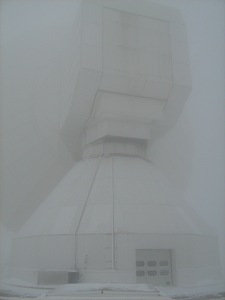
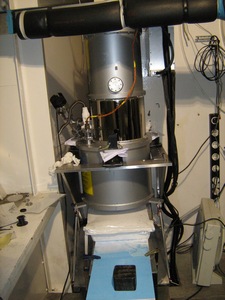
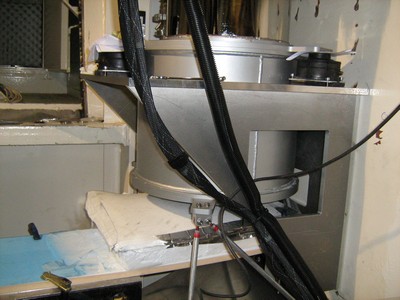
Saturday 14/04 - Sunday 15/04
Strong wind and snow ![]() . Snowstorm. !!Careful when walking outside below the antenna!!
. Snowstorm. !!Careful when walking outside below the antenna!!

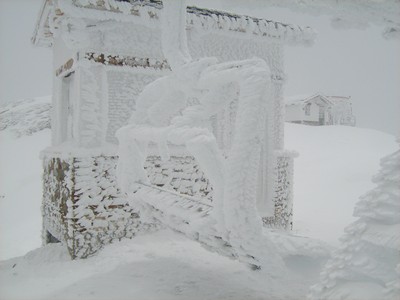
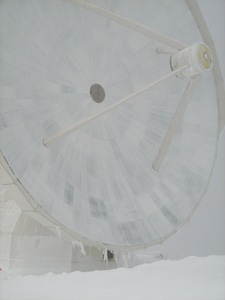
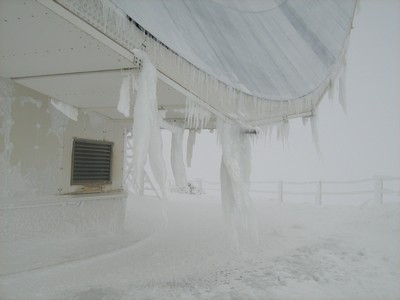
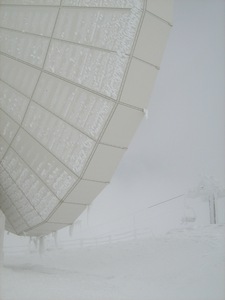
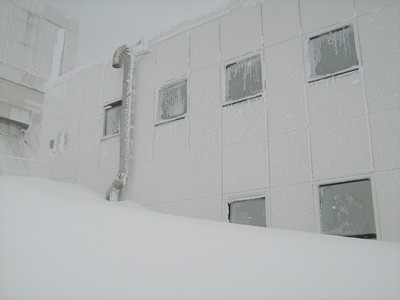
Monday 16/04
Waiting for the icicles in the rim of the primary to disappear. Starting to observe at 11:30pm local time, only to be stopped at about 2am because of high wind.
Tuesday 17/04
Only very few hours of observing time before maintenance shift started at 11am. Starting to do focus check after recycling an d maintenance at 4:30pm, only to realize that GISMO warms-up. It seems there is a leak somewhere. Sealing-off the big window during recycling, to prevent Helium to enter, may help. At 10:30pm starting again.
Some great maps have been obtained in the last week:
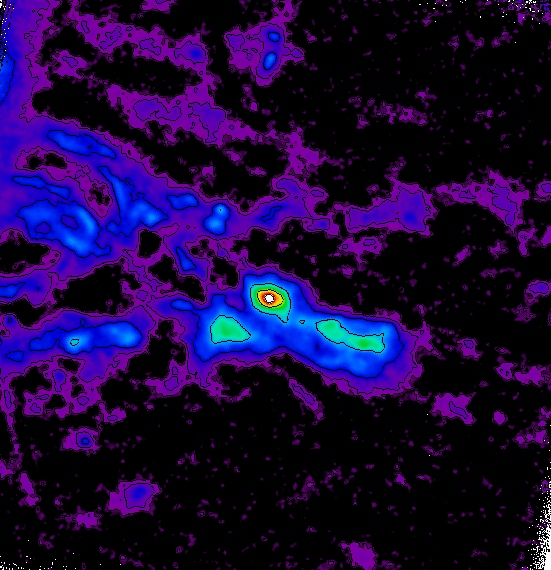
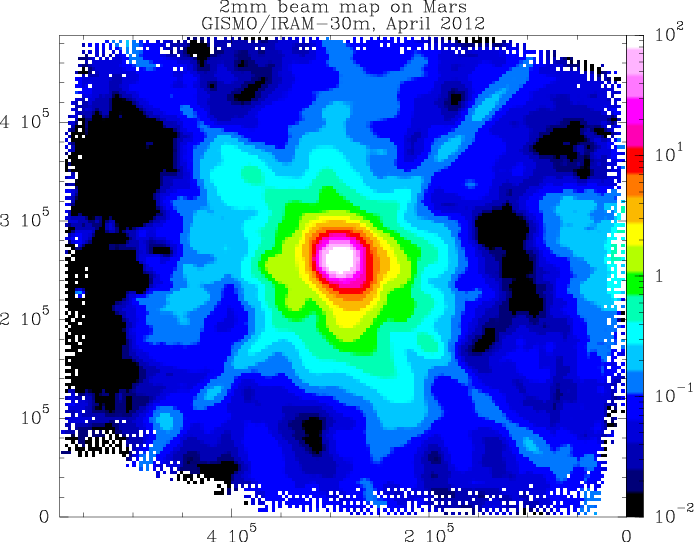
Left: A map of the Galactic center covering roughly 28x35 arcmin. The image was obtained in 20 minutes of integration (log scale). The bright peak in the center is SgrA (about 4.7 Jy). The map rms is ~6 mJy/beam. Contours are shown at 10 mJy, 30 mJy, 100 mJy, 0.3 Jy, 1.0 Jy, and 3.0 Jy. Right: A beam map on Mars with about 40dB in dynamic range.
Wednesday 18/04
Observations continue without major problems. Between midnight sensitivity went up from 10 and 17 and stayed there for about 5 hours, although the instrument had not been touched. About 2.5 hours spent on the Galactic Center. First results look very well.
Observations stopped at ~8:30 UT. Weather was unstable. Waiting for low and stable tau measurements. Time series of the noise show spikes and jumps of the sensitivity, also under stable weather conditions, and also after closing the window with a cap.
Stopped from 13 UT to 15 UT due to a new re-filling of Gismo. A cap was put in front of the entrance window, to avoid that any Helium gas is sucked into the dewar. This hopefully helps with the cryogenic problems. One source for spikes and jumps was identified; after isolating the IRIQB cable, somewhat less problems are seen.
Stopped since 23 local time because of thick clouds and some light snowfall, once again.
Thursday 19/04
Bad weather continues. It was impossible to open the telescope in the whole day. Similar images to those from last Saturday can be seen outside the building.
Friday 20/04
Finally the weather had allowed us to go on with Gismo Pool since 10 a.m.
Focus observing scripts was modified. Now it performs 5 lissajous maps of 90" during 1 minute of time. The five scans are observed with focus offsets: -1.2, -0.6, 0.0, 0.6, 1.2 respect the last focus correction. It also was created a script to reduce focus observations and to get the new focus correction. Below is shown the figure returned by this program:
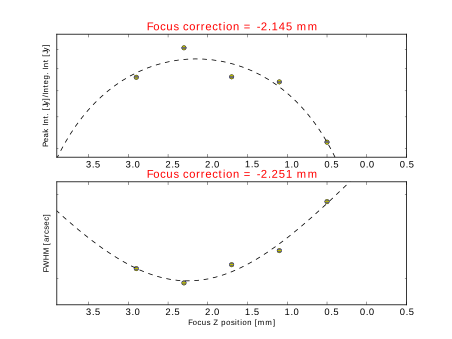
The new taumeter is not working since this afternoon at 17:30 UT. Now the old one, which was giving consistent readings during the previous 3 hours, is being used.
During the afternoon, Gismo team added a magnetic insulation and reinstituted ground connection through the power system. By doing this, the spikes and jumps related in Wednesday have finally dissapear. Now, in observations of 10 minutes at tau~0.4 and elevations lower than 30 degrees, the reached rms is about 10mJy.
Saturday 21/04
The new taumeter is working again. Observations go on smoothly since Friday, stopping only for re-filling Gismo.
A printed version from Crush manual is now available at the 30m telescope.
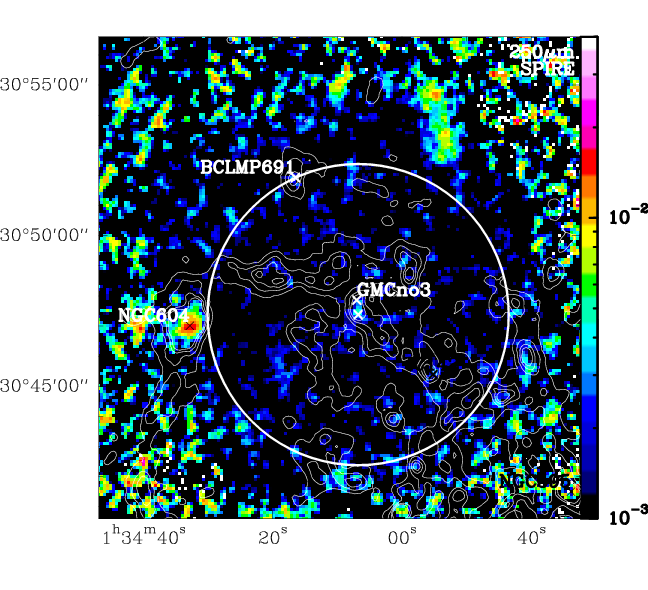
First shot at M33 centered on GMCno3, observed in about 1.5hours with 10'x10' otf. Contours are 250um SPIRE/Herschel emission. The circle has a diameter of 10'. A quick reduction shows NGC604, lying just at the eastern edge, and is clearly detected at about 15mJy/beam, and GMCno3 which is tentatively detected. The noise level in the central part of the map is less than about 2mJy/beam.
Sunday 22/04
Observations are still running smoothly since Friday. Stopped after refilling due to clouds and fog.
Monday 23/04
Observing since 00:30. Observations have run smoothly during the whole day. Just a technical stop to refill Gismo was needed.
Tuesday 24/04
Observing without problems during the night. The first Gismo Pool has ended, after 72 hours of science observations. This is really only the on-source time, slewing and other overheads are not included.
